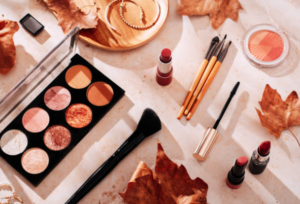The Dark Side of Cosmetics

In the enchanting world of beauty, where the promise of radiant skin and flawless makeup beckons, there lies a darker side—an industry secret often overlooked. While cosmetics contribute to our self-expression and confidence, some products harbor harmful ingredients that can have adverse effects on our skin and overall health. In this in-depth exploration, we unveil the dark side of cosmetics, shedding light on the harmful ingredients lurking in face makeup. Arm yourself with knowledge, empower your choices, and let’s delve into the ingredients you should avoid to ensure your beauty routine remains a source of joy, not harm.
The beauty industry operates in a space that lacks stringent regulations compared to other sectors. This leaves room for the inclusion of potentially harmful ingredients without consumers’ knowledge. Understanding this unregulated landscape is the first step in making informed choices.
Our skin, the largest organ, absorbs a significant portion of what we apply to it. What we put on our face can find its way into our bloodstream, potentially affecting our health over time. Recognizing the skin’s vulnerability emphasizes the importance of scrutinizing product formulations.
Common Culprits in Face Makeup
A. Parabens: The Preservative Predicament
Parabens are synthetic preservatives widely used in cosmetics to extend shelf life. They are known for their antimicrobial properties, preventing the growth of bacteria and mold. However, the use of parabens in cosmetics has raised concerns due to their ability to mimic estrogen in the body.
– Concerns:
- Endocrine Disruption: Parabens can interfere with the endocrine system, potentially disrupting hormonal balance. Studies have linked prolonged exposure to parabens with hormonal imbalances and reproductive issues.
- Breast Cancer Risk: Some research suggests a potential connection between parabens and an increased risk of breast cancer. Parabens have been detected in breast tissue, although more research is needed to establish a direct link.
– Commonly Found in:
- Foundations
- Concealers
- Powders
- Blushes
– Safer Alternatives:
Look for products labeled as “paraben-free” and opt for cosmetics that use alternative preservatives such as tocopherol (vitamin E), rosemary extract, or grapefruit seed extract.
B. Phthalates: The Plasticizers in Disguise
Phthalates are a group of chemicals used to enhance the texture and flexibility of cosmetics. They are often found in products with a gel-like consistency, such as foundations and creams.
– Concerns:
- Endocrine Disruption: Like parabens, phthalates can disrupt the endocrine system and may contribute to hormonal imbalances.
- Reproductive Issues: Exposure to certain phthalates has been associated with adverse effects on reproductive health, including reduced fertility.
– Commonly Found in:
- Foundations
- Cream-based products
- Fragrances
– Safer Alternatives:
Choose products labeled as “phthalate-free” and opt for cosmetics with a more solid, wax-based consistency to reduce the need for plasticizing agents.
C. Formaldehyde-Releasing Agents: The Unwelcomed Preservers
Formaldehyde-releasing agents are used as preservatives in cosmetics to prevent bacterial growth. They gradually release small amounts of formaldehyde over time.
– Concerns:
- Skin Irritation: Formaldehyde-releasing agents can cause skin irritation, especially in individuals with sensitive skin.
- Carcinogenic Potential: Formaldehyde is classified as a human carcinogen, and while the amounts released in cosmetics are small, cumulative exposure can pose health risks.
– Commonly Found in:
- Foundations
- Setting sprays
- Nail polishes
- Eyelash adhesives
– Safer Alternatives:
Opt for products that use alternative preservatives such as phenoxyethanol, ethylhexylglycerin, or sodium benzoate.
D. Talc: The Hidden Contaminant
Talc is a mineral often used in powder products for its silky texture. However, talc deposits can sometimes be contaminated with asbestos, a known carcinogen.
– Concerns:
- Asbestos Contamination: Asbestos, a naturally occurring mineral, has been found in some talc deposits. Inhaling asbestos can lead to serious respiratory issues.
- Cancer Risk: While cosmetic-grade talc is required to be asbestos-free, the potential for contamination has led to concerns about its safety.
– Commonly Found in:
- Powders
- Blushes
- Eyeshadows
- Foundations
– Safer Alternatives:
Look for talc-free alternatives that use ingredients like cornstarch, rice powder, or arrowroot powder.
E. Fragrance: The Mysterious Mask
Fragrance, often listed simply as “fragrance” or “parfum” on ingredient lists, is a cocktail of chemicals used to create a specific scent in a product.
– Concerns:
- Allergies and Sensitivities: Fragrance is a common cause of skin allergies and sensitivities, leading to redness, itching, and irritation.
- Respiratory Issues: Synthetic fragrances can emit volatile organic compounds (VOCs), contributing to indoor air pollution and potentially triggering respiratory issues.
– Commonly Found in:
- Almost all types of cosmetics, including foundations, powders, lip products, and skincare.
– Safer Alternatives:
Opt for fragrance-free or products scented with natural essential oils. Brands that prioritize transparency often disclose the specific ingredients used in their fragrance blends.
By being aware of these common culprits and understanding their potential risks, consumers can make informed decisions when selecting face makeup products, ultimately prioritizing both their beauty and overall health.

The Impact of Heavy Metals
A. Lead: The Heavy Metal Menace
Lead, a heavy metal, has historically been used in cosmetics for its pigmenting properties. However, the potential health risks associated with lead exposure have led to increased awareness and scrutiny.
– Concerns:
- Neurotoxicity: Lead is a potent neurotoxin that can adversely affect the nervous system, leading to cognitive impairments, especially in children.
- Accumulation: Prolonged exposure to lead, even in small amounts, can result in its accumulation in the body over time, contributing to chronic health issues.
- Developmental Delays: In pregnant women, exposure to lead can result in developmental delays in the fetus, impacting both physical and cognitive development.
– Commonly Found in:
- Lipsticks
- Lip glosses
- Some foundations
– Safer Alternatives:
Choose lead-free cosmetics and prioritize products from brands that have rigorous testing and quality control measures in place.
B. Mercury: The Skin-Lightening Saboteur
Mercury is a heavy metal that has been used in some cosmetics, particularly in skin-lightening products, due to its skin-whitening properties.
– Concerns:
- Skin Damage: Mercury can cause skin discoloration, rashes, and scarring. Prolonged use can lead to the thinning of the skin and the development of “acquired ichthyosis.”
- Systemic Toxicity: Absorption of mercury through the skin can result in systemic toxicity, affecting the kidneys, nervous system, and other organs.
– Commonly Found in:
- Skin-lightening creams
- Mascara
- Eyeliners
– Safer Alternatives:
Avoid products that list mercury, calomel, mercurio, or mercuric as ingredients. Opt for natural and botanical alternatives for skin-lightening purposes.
C. Arsenic: The Silent Poison
Arsenic, a naturally occurring element, can be found in trace amounts in some cosmetics. While the levels are generally low, consistent exposure can pose health risks.
– Concerns:
- Skin Irritation: Arsenic exposure can lead to skin irritation and the development of skin lesions.
- Respiratory Issues: Inhalation of arsenic particles, which can occur during the application of powders, may contribute to respiratory issues.
- Long-Term Health Effects: Chronic exposure to arsenic is associated with an increased risk of cancer, particularly skin, lung, and bladder cancer.
– Commonly Found in:
- Some eyeliners
- Eyeshadows
- Face powders
– Safer Alternatives:
Choose products from brands that rigorously test for heavy metals and adhere to safety regulations. Opt for arsenic-free cosmetics whenever possible.
D. Cadmium: The Undesired Pigment
Cadmium is a heavy metal often used in pigments to create vibrant and long-lasting colors. However, its toxicity raises concerns about its presence in cosmetics.
– Concerns:
- Carcinogenicity: Cadmium is classified as a carcinogen, and long-term exposure is associated with an increased risk of lung and prostate cancer.
- Respiratory Issues: Inhalation of cadmium particles, especially in powder products, can contribute to respiratory issues.
- Skin Irritation: Direct contact with cadmium can cause skin irritation and allergic reactions.
– Commonly Found in:
- Some eyeshadows
- Blushes
- Nail polishes
– Safer Alternatives:
Opt for brands that prioritize the use of alternative pigments or adhere to strict quality control measures to minimize the presence of cadmium in their products.
By being vigilant about heavy metals in cosmetics and making informed choices, consumers can minimize their exposure to these potentially harmful substances. Checking ingredient lists, choosing reputable brands, and staying informed about product safety are key steps in ensuring that the beauty products we use contribute to our well-being rather than posing risks to our health.

Navigating the Ingredient Lists
The Art of Reading Labels:
Understanding how to read cosmetic labels empowers consumers to identify potential red flags. Familiarize yourself with ingredient names and be on the lookout for vague terms like “fragrance” or “parfum.”
Seeking Transparency from Brands:
Choose brands that prioritize transparency. Look for those that disclose their full ingredient lists, avoid ambiguous terms, and provide detailed information about the sourcing and safety of their ingredients.
Clean Beauty Movement:
The clean beauty movement advocates for products free from harmful chemicals, emphasizing natural and non-toxic formulations. Explore brands that align with this ethos, prioritizing your health and the environment.
DIY Makeup Solutions:
For those with a flair for creativity, venture into the world of DIY makeup. Crafting your products allows you to control the ingredients, ensuring a personalized, safe, and effective beauty routine.
Educating Yourself:
Stay informed about emerging research on cosmetic ingredients. A continuously evolving understanding of beauty science empowers consumers to make informed choices for their well-being.

As we traverse the enchanting realm of cosmetics, it’s crucial to acknowledge the darker aspects hidden beneath the glittering surface. The harmful ingredients in face makeup pose potential risks to our health, demanding our attention and scrutiny. Armed with knowledge, we can navigate the beauty landscape with confidence, making informed choices that prioritize our well-being. Embrace the power of informed consumerism, demand transparency from brands, and let your beauty routine be a source of joy and health, devoid of the silent dangers that linger in the shadows.




